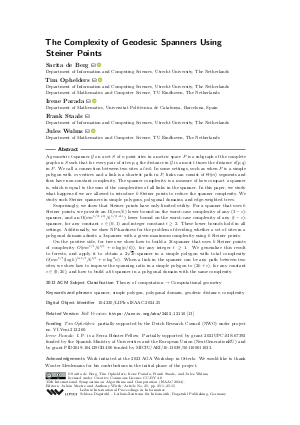LIPIcs.ISAAC.2024.25.pdf
- Filesize: 1.13 MB
- 15 pages

 Creative Commons Attribution 4.0 International license
Creative Commons Attribution 4.0 International license

A geometric t-spanner 𝒢 on a set S of n point sites in a metric space P is a subgraph of the complete graph on S such that for every pair of sites p,q the distance in 𝒢 is a most t times the distance d(p,q) in P. We call a connection between two sites a link. In some settings, such as when P is a simple polygon with m vertices and a link is a shortest path in P, links can consist of Θ (m) segments and thus have non-constant complexity. The spanner complexity is a measure of how compact a spanner is, which is equal to the sum of the complexities of all links in the spanner. In this paper, we study what happens if we are allowed to introduce k Steiner points to reduce the spanner complexity. We study such Steiner spanners in simple polygons, polygonal domains, and edge-weighted trees.
Surprisingly, we show that Steiner points have only limited utility. For a spanner that uses k Steiner points, we provide an Ω(nm/k) lower bound on the worst-case complexity of any (3-ε)-spanner, and an Ω(mn^{1/(t+1)}/k^{1/(t+1)}) lower bound on the worst-case complexity of any (t-ε)-spanner, for any constant ε ∈ (0,1) and integer constant t ≥ 2. These lower bounds hold in all settings. Additionally, we show NP-hardness for the problem of deciding whether a set of sites in a polygonal domain admits a 3-spanner with a given maximum complexity using k Steiner points.
On the positive side, for trees we show how to build a 2t-spanner that uses k Steiner points of complexity O(mn^{1/t}/k^{1/t} + n log (n/k)), for any integer t ≥ 1. We generalize this result to forests, and apply it to obtain a 2√2t-spanner in a simple polygon with total complexity O(mn^{1/t}(log k)^{1+1/t}/k^{1/t} + nlog² n). When a link in the spanner can be any path between two sites, we show how to improve the spanning ratio in a simple polygon to (2k+ε), for any constant ε ∈ (0,2k), and how to build a 6t-spanner in a polygonal domain with the same complexity.



Feedback for Dagstuhl Publishing